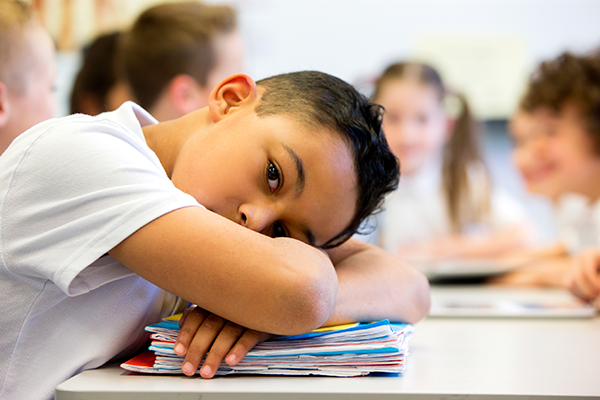How Can Teachers Support Students With Trauma?
Here at Calm Classroom, we talk a lot about trauma-informed learning. That’s because we deeply understand how important it is to understand how trauma affects children and what educators’ role is in supporting them.
Reports show that trauma is very common among school-aged children – between 25% and 60% – and you may very likely have a child who’s been affected by trauma in your new class.
Often, we think of trauma as the school counselor’s arena. And while that may be true to an extent, teachers are often one of the primary adult relationships that children have in their lives. You, too, play an important role in supporting students affected by trauma.
Signs that a child has experienced trauma
First of all, it’s important to be able to recognize when students’ behaviors are a result of trauma. This helps us as educators have more empathy for student behaviors that might be otherwise classified as “difficult.”
Trauma affects children in different ways, and human beings also have varying resilience levels when it comes to these difficult experiences. This list will not apply to every student you work with who’s affected by trauma, so it’s important to pay attention to your gut instincts as well.
But in general, children who are affected by trauma will display signs like:
- Academic decline: A marked decline in academic performance, particularly if it's inconsistent with the student's previous abilities, can be a sign trauma. Traumatic experiences can affect a student's ability to concentrate, retain information, and engage in learning. Pay attention to which children have trouble paying attention or seem disengaged in your classroom; although this isn’t necessarily a sign of trauma, it could be.
- Emotional dysregulation: Trauma can trigger intense emotions that a student may struggle to manage. Keep an eye out for frequent mood swings, emotional outbursts, or extreme reactions to seemingly minor things. These outbursts can be an expression of underlying trauma-related distress.
- Avoidance: Students affected by trauma may avoid situations, people, or topics that remind them of their traumatic experiences. For example, you might see a child feeling reluctant to attend school, participate in specific activities, or engage in any conversations about their home life.
- Physical complaints: Unexplained physical complaints, such as headaches, stomachaches, or other somatic symptoms, are sometimes a way for students to express their emotional pain. If you have a student who’s always telling you something hurts, t's essential to explore whether these complaints might have underlying psychological causes.
- Poor boundaries: We tend to think of students affected by trauma as angry or even confrontational, but sometimes they’re the most affectionate child in the room. If you notice that a child seems to attach to you unusually quickly, overshares with other students, or doesn’t seem to understand the concept of personal space, then this could be a sign of trauma.
- Social isolation: Students affected by trauma may isolate themselves from other children. They might avoid social interactions and prefer spending time alone. Pay attention to the children who are spending recess alone.
- Regression: Trauma can lead to regression in behavior and development. This means that the child could go back to an earlier period of development. Keep an eye out for signs of regression, such as bedwetting, thumb-sucking, or using baby talk.
- Hyperarousal: Some students may become hyperaroused as a result of trauma, making them overly vigilant or easily startled. You might notice that they are “jumpy” or get frightened at loud sounds.
- Difficulty trusting adults: While some children affected by trauma can develop poor boundaries and become overly attached to other adults in their lives, others (understandably) develop a general mistrust of adults. If a child seems scared to be alone with any adult or is standoffish in their behaviors toward all adults, keep an eye on them.
- Self-harming behaviors: In some cases, students affected by trauma engage in self-harming behaviors like cutting, biting, or hitting their head on the wall as a way to cope with emotional pain. Keep an eye out for signs of self-harm, like unexplained cuts or bruises.

How to support students affected by trauma
Once you’ve recognized that a student is affected by trauma, whether it’s through recognizing and investigating signs or being alerted by a counselor or parent, then there are many things you can do within your role as their teacher to help support them.
Focus on building relationships
It’s easy to start feeling helpless when you learn that a child you teach has gone through trauma. After all, you only see them at school and can’t protect them at home. Does anything you do make a difference?
The answer is an astounding yes – you absolutely do make a difference! Research shows that having just one healthy relationship with an adult can make children much more resilient against trauma. Whether or not you can physically protect them, just building a healthy and safe relationship with them can change the course of their lives.
There are things you can do to try to protect children further, but focus on building a relationship with them first and foremost.
Understand their needs
Next, understand that children affected by trauma have unique needs. They may require additional emotional support, patience, and understanding. Trauma can manifest in various ways, and it's crucial to tailor your approach to meet each student's specific needs.
Each student affected by trauma will be unique so you will need to get to know them as well as any supportive people in their life to determine what exactly they need from you at school. But simply understanding that they may have additional needs can be helpful.
Focus on strengths
It’s easy for children affected by trauma to be labeled as a “troubled” child. Especially if their trauma history is well-known – trauma history should always be kept confidential, but unfortunately sometimes information gets around on school campuses – then it could lead adults to only view them as a child who has overcome trauma.
Try to always remember that no child – or person – is defined by their trauma. Focus on this child’s strengths and interests – not only strengths that relate back to the trauma, such as “resilience,” but strengths that have nothing to do with their most painful experiences.
For example, perhaps one student really loves soccer and another is an avid reader and reads well above their grade level. See the child for all of their strengths and qualities, not just for what they’ve been through.
Be consistent
You may fear being too hard on a child affected by trauma because of what they’ve been through. But building strong relationships with these students doesn’t mean that you should allow them to behave in any way they want. Children affected by trauma are often vulnerable because they haven’t had any boundaries or consistency in their lives – and children need consistency. Consistency is predictable, and predictability is safe.
Be consistent about rules and boundaries in your classroom. Ensure that all of your students, including those affected by trauma, know exactly what the expectations are, and what the rewards and consequences will be for certain actions.
Be very consistent about following up with rewards and consequences. The goal is for your students to know exactly what to expect when they’re in your classroom. This can help reduce hypervigilance and make all students feel safe.
Refer to counseling
Often, children affected by trauma will require further mental health treatment to fully process and heal from their experiences. Your school counselor or social worker is a great resource to point you in the right direction. They can help connect your student to mental health resources in the community.
Use trauma-informed mindfulness and SEL exercises
Lastly, providing trauma-informed mindfulness and SEL lessons for all of your students can ensure that no student falls through the cracks when it comes to these important life skills. Research has shown that mindfulness and other SEL programs can help people become more resilient to trauma. By teaching your students these skills, you can better their odds of becoming happy and well-functioning adults regardless of their trauma background.
Calm Classroom makes it simple and easy to start incorporating age-appropriate mindfulness lessons into your classroom right away. Get in touch with us to learn more about our training options!





SIGN UP FOR OUR NEWSLETTER